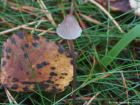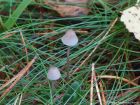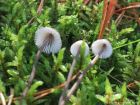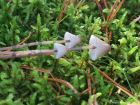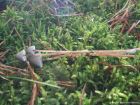Cap initially conic in shape, and expands to hemispheric in maturity, with sulcate and translucent-striate characteristics. Initially pruinose and glabrescent, it starts as a blackish violet and gradually changes to bluish grey or greyish, sometimes with a subtle violet tint. The centre remains dark grey, eventually shifting to shades of grey or grey-brown. The flesh is whitish and thin. Gills extend to the stipe, ascending, and are narrowly adnate to slightly broader adnate, but not decurrent with a tooth. In young specimens, they may appear violet-blue, later turning white to grey, sometimes with a brownish tint. Stem hollow, straight to slightly curved, cylindrical, and uniform in thickness. It is pruinose and smooths out with age, except for the pruinose apex. The colour ranges from lilac-grey to slate-grey, becoming darker towards the base. It has no ring. Spore print white or very pale buff.
Microscopic Features: Spores measure 7-10.2 x 3.5-5 μm. They are pip-shaped, smooth, and amyloid.
Mycena urania on the mycena.no Web site.
Many mushrooms are poisonous, and some can be lethally toxic. Distinguishing between edible and poisonous mushrooms can be very challenging. Therefore, we strongly advise against consuming wild mushrooms. This website does not contain any information about the edibility or toxicity of mushrooms.
Although efforts have been made to ensure accuracy on this website, the information may contain errors and omissions. Therefore, all content provided is for educational and informational purposes only and should not be relied upon or used as a basis for consuming any plants or mushrooms.
External links are provided for reference only. We do not endorse or take responsibility for the content, advice, or products found on these sites or in any advertisements shown on this website.
